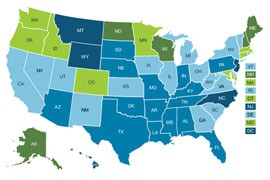Cronkite News has moved to a new home at cronkitenews.azpbs.org. Use this site to search archives from 2011 to May 2015. You can search the new site for current stories.
Report gives Arizona a D for poor kids’ access to dental sealants
WASHINGTON – Arizona got a D on a national report card on low-income kids’ access to cavity-preventing sealant, which supporters call a “cost-effective, evidence-based, preventative service” that improves dental health in the long run.
It was one of 15 states to get a D – five earned F’s – in the study by the Pew Center on the States, which looked at four benchmarks that it says should be in all states’ dental-prevention strategies.
Arizona failed on three: the percentage of low-income schools with sealant programs, the number of children with sealants and the requirement that dentists oversee a dental hygienist’s application of sealant.
“It’s a cost-effective, evidence-based, preventative service that every state should make a priority, and they’re not,” said Shelly Gehshan, director of the Pew Children’s Dental Campaign Project.
Arizona had what Pew called “severe restrictions” because of the state’s requirement that a dentist examine a patient before a sealant – a clear plastic coating applied to chewing surfaces on molars – can be applied. Pew recommends that dental hygienists be allowed to place sealants without a dentist’s oversight.
“The whole system fails because we put up these barriers,” said Kevin Earle, executive director of the Arizona Dental Association. “If you take away that barrier, then more kids can be seen.”
Earle said another part of the state law could be read loosely to allow dental hygienists to apply sealants without a dentist. If necessary, however, a simple fix would be to add the word “sealant” into the code, something Earle said he is now looking in to.
“If there’s a flaw in the law, that’s it,” said Earle, who is also a former director of the Arizona State Board of Dental Examiners. “If we really had to fix this, it would be an easy fix.”
As for the benchmark that requires sealant programs in three-fourths of low-income schools, a state official said Arizona’s Medicaid program provides dental care that does not require school-based treatment.
“The Medicaid program is not a D,” said Monica Coury, spokeswoman for the Arizona Health Care Cost Containment System.
She said Medicaid recipients in Arizona are on plans that include dental, so they have no need for school-based programs. Coury added that it is valuable for kids to build a relationship with a dentist and have the opportunity for checkups and continued coverage, which is not available in sealant programs.
But Bill Maas, an adviser to the Pew dental project, said in-school sealant programs were created precisely because studies found poor kids were not receiving sealants, even those on Medicaid.
The Pew report states that in 2009 and 2010, only 26 percent of children living under the poverty line had sealants.
“I’m happy for the kids who got the care, but I’m thinking about the kids who didn’t get care and what’s going to happen to them,” Maas said.
Gehshan said states are not providing sealant services across the board largely because they have not revisited the issue in years or don’t recognize the effectiveness of sealants.
She said Pew would likely revisit the issue in about two years to give state lawmakers time to correct some of the policy problems it found.
Only five states – Alaska, Maine, New Hampshire, North Dakota and Wisconsin – received an A on the Pew report card.
One dental health official in Arizona said she hopes the Pew report can bring attention to the issue.
“We have counties in Arizona where children get no care because we don’t have (dentists),” said Kirsten Roling, program supervisor in the Office of Oral Health in the Maricopa County Department of Public Health.
“I’m hoping with a report like this, other providers and those who read it, it opens their eyes to what these barriers are,” she said.







